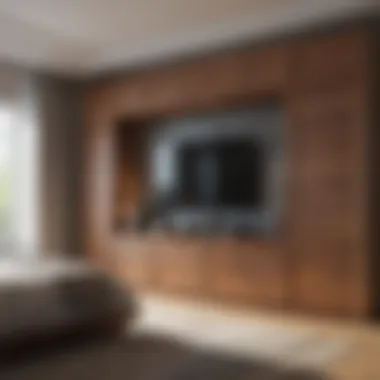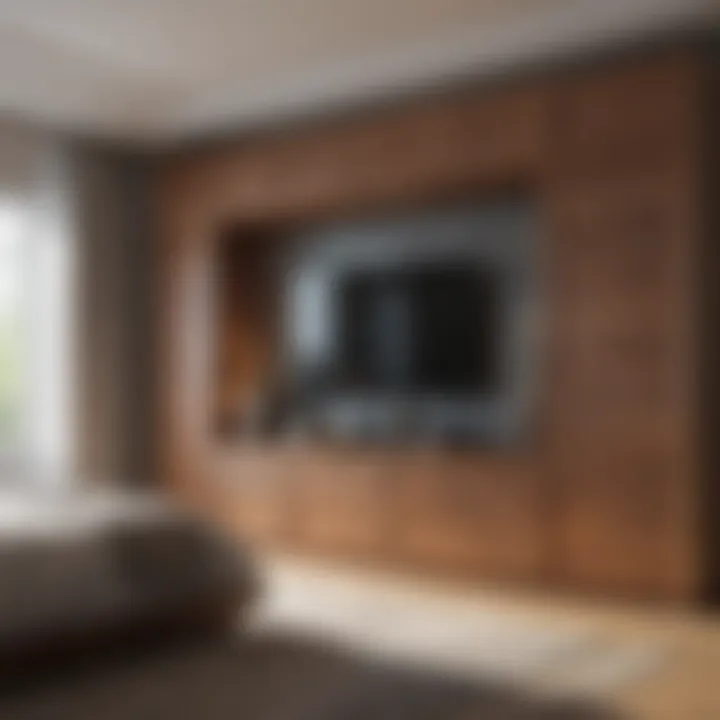4 Bedroom Plan Design: Balancing Aesthetics and Functionality


Intro
Designing a four-bedroom plan is not just about allocating space; it is a balance between functionality and aesthetics. An optimal layout can foster a sense of comfort, enhance daily living, and reflect personal style. In this article, we will delve into the intricacies of creating four-bedroom designs that cater to both practical needs and contemporary tastes. Homeowners and renters alike can benefit from informed choices that elevate their living environments into welcoming and efficient spaces.
We will explore critical design elements, emerging trends, and practical tips that can guide individuals in their decision-making process. It is essential to consider how each space interacts with the others in a four-bedroom home. This understanding boosts coherence and flow throughout all rooms, turning a house into a true home.
Design Inspirations
Design inspirations set the stage for the creative journey of home design. They help shape ideas and establish a cohesive atmosphere.
Trending Styles
In recent years, homeowners have gravitated towards several distinct styles, each offering unique benefits:
- Modern Minimalism: This style emphasizes simplicity and functionality. Clean lines and muted colors create serene habitats.
- Scandinavian Design: Characterized by light colors, natural materials, and integrated functionality, Scandinavian design is perfect for cozy yet spacious interiors.
- Industrial Chic: This style mixes raw materials with elegance. Exposed brick and metal fixtures form an appealing contrast, suitable for a contemporary urban feel.
- Transitional Design: A blend of traditional and contemporary elements makes this style adaptable and timeless.
Each style has its defining characteristics. The choice ultimately reflects personal preference and how it complements the home’s environment.
Color Palettes
Color plays a crucial role in setting the mood of each bedroom. When selecting a palette, consider the following:
- Neutral Tones: Whites, greys, and beiges provide a calming backdrop, offering versatile spaces for decoration.
- Pastel Shades: Soft blues, pinks, or greens can evoke tranquility and encourage relaxation, ideal for bedrooms.
- Bold Accents: Accessories or feature walls in rich colors can introduce vitality to a space without overwhelming the senses.
Carefully selected color palettes can transform a bedroom into a tranquil sanctuary or an energetic retreat.
"The right combination of styles and colors can not only enhance aesthetics but also improve the functionality of each room."
Product Recommendations
When equipping a four-bedroom home, selecting the right products can significantly impact the overall effectiveness of design. Here are some essential recommendations:
Bath Accessories
- Shower Caddies: These practical tools help keep toiletries organized and accessible.
- Bath Mats: Choose absorbent and comfortable mats that elevate the bathroom’s look.
- Storage Solutions: Baskets or shelving units help maintain order in any bathroom.
Bedroom Essentials
- Quality Mattresses: Investing in a good mattress ensures restful sleep.
- Bedding Sets: Opt for coordinated sets that blend well with your color palette.
- Nightstands: Functional nightstands provide storage and surface area for personal items.
Product selection should align with the design goals of each room. Thoughtfulness in these choices contributes to a harmonious living environment.
By integrating design inspirations, color palettes, and essential products, homeowners can embark on a rewarding journey to create a well-planned four-bedroom home.
Understanding the Essentials of a Bedroom Plan
Creating a well-designed four-bedroom plan is no small feat. It requires careful consideration of various elements that merge both functionality and aesthetics. A well-structured plan can significantly enhance the overall living experience. It enables an optimal flow of space, ensuring that residents can navigate their environment comfortably.
The benefits of a solid four-bedroom layout extend beyond mere appearance. It addresses practical needs, such as privacy and shared spaces. Knowing what works best for a family or group can lead to better harmony within the home. Moreover, a thoughtfully designed plan can facilitate future adjustments or renovations, adapting to changing family dynamics.
Defining Your Space Requirements
When defining your space requirements, you start by analyzing your lifestyle. Do you need additional areas for hobbies, like an office or a playroom? It’s essential to list all needs before engaging in a design process. Consider how much space is necessary for each room. Four bedrooms could mean different configurations—shared rooms, guest rooms, or nurseries. Each aspect has implications on how the home feels and functions.
Look into specific measurements and layout preferences. Think about the size of the furniture and whether there must be additional storage or functional areas. A well-planned space considers each room’s purpose in conjunction with others. For instance, if two bedrooms share a bathroom, its placement can greatly affect privacy and accessibility.
Identifying User Needs
Identifying user needs is a fundamental aspect of planning your four-bedroom design. This involves understanding the occupants' lifestyles, preferences, and daily routines. Conduct discussions to gather input from everyone who will live in the home. For some, quiet zones may be essential—places for relaxation and study. Others might prioritize communal areas for family gatherings or entertaining guests.
It’s beneficial to consider the ages and stages of users as well. Families with small children may have different requirements compared to multi-generational households. Think about future needs, as well. Will there be more family members or changes in the occupants’ lifestyles? Researching different lifestyle changes can guide thoughtful design choices that anticipate such shifts.
"Understanding the user needs transforms a generic space into a personalized home that echoes the inhabitants' values and preferences."
In summary, a comprehensive understanding of the essentials of a four-bedroom design is critical for anyone looking to create meaningful living spaces. Defining space requirements and identifying user needs form the bedrock of robust planning, ultimately benefiting both aesthetics and functionality.
Exploring Design Layout Options
The layout of a four-bedroom home plays a crucial role in shaping the experience of its inhabitants. Effectively exploring design layout options helps in maximizing both functionality and aesthetics. A well-thought-out layout can enhance communication between spaces, cater to differing privacy needs, and ensure that each bedroom is used to its full potential. Every homeowner should carefully consider how they can create cohesive environments that foster comfort and efficiency.
Open Floor Plans vs. Traditional Layouts
Open floor plans have gained popularity over the years, especially among younger families and modern homeowners. This approach offers a sense of spaciousness and connectivity, allowing for fluid movement between living areas. For instance, combining the kitchen, dining, and living spaces facilitates social interaction and family togetherness. Appliances from Samsung or LG can merge seamlessly into this layout, creating a convenient flow.
However, it is essential to note that an open floor design may have drawbacks. Noise levels can rise, and lack of defined spaces may lead to visual clutter. In contrast, traditional layouts offer defined spaces, providing much-needed privacy and separation. Bedrooms can be situated away from common areas, ideal for those needing quiet zones for work or relaxation. Homeowners should assess their lifestyle and preferences to determine which option best aligns with their needs.
Utilizing Vertical Space
Incorporating vertical space can often be overlooked yet profoundly effective. High ceilings present opportunities for creative design elements, like tall bookshelves or hanging plants. IKEA offers a wide range of shelving solutions that can take advantage of these heights, maximizing storage while enhancing decor.
Adding vertical elements not only champions organization but also increases the perceived size of a room. This technique can create an airy atmosphere when combined with appropriate lighting and subdued colors. For instance, floor-to-ceiling windows can flood the space with natural light, making even a smaller room feel expansive. Therefore, exploring vertical space is vital for enhancing both aesthetics and functionality in a four-bedroom home.
Key Design Principles for Bedroom Planning
Designing a four-bedroom plan involves careful consideration of various elements to ensure both functionality and aesthetic appeal. The principles adhered to during the planning phase define the success of the end result. Well-executed design principles can enhance comfort, promote relaxation, and optimize space. As such, they serve as a blueprint for creating spaces that echo individual taste yet remain practical for daily living.
Focusing on Light and Space
Light plays a critical role in bedroom design. Proper lighting can transform a room, making it feel larger and more inviting. Natural light sources such as windows should be maximized. Consider placing beds near windows to allow sunlight in during the day. Additionally, utilizing reflective materials, like mirrors or glass decor, can help distribute light throughout a room effectively.
Artificial lighting also must be planned alongside natural light. Layered lighting with ambient, task, and accent sources caters to various needs. For example, bedside lamps provide necessary light for reading, while overhead fixtures establish general illumination. This blend of lighting creates vibrant and versatile bedroom spaces.
Color Theory in Bedroom Design
Color choice is another fundamental principle in bedroom planning. It impacts mood and perceived space vastly. Lighter shades, such as soft pastels or neutral tones, often produce a sense of openness and tranquility. In contrast, darker colors can convey warmth but may also make the space feel smaller.
When selecting a color scheme, think about the desired atmosphere. Some may wish for a calm and restful sanctuary while others prefer a dynamic environment. Creating a coherent color palette is essential for unifying the room’s aesthetic. Consider accent walls or coordinating textiles to achieve depth in color while maintaining harmony.
Furniture Placement Considerations
The arrangement of furniture is vital to how a bedroom functions. Proper placement can facilitate movement and encourage a more ideal use of space. It is prudent to create clear pathways throughout the room. Generally, beds should be the focal point. Ideally, allow for easy access on both sides for convenience.
In addition, consider multifunctional furniture, like a storage bed or side tables with drawers. This helps minimize clutter by maximizing storage solutions. When planning the layout, ensure that every piece serves a purpose.


"Furniture should promote ease of movement while providing comfort and style."
By adhering to these design principles, a four-bedroom plan can evolve into functional and aesthetic spaces, tailored to meet the specific needs of the occupants. Combining light, color, and furniture placement creates rooms that invite relaxation, showcase personal style, and facilitate everyday living.
Incorporating Functional Elements
Incorporating functional elements into a four-bedroom plan is crucial for maximizing both comfort and usability. When designing these spaces, it is important to focus on how each room will be used. Understanding the needs and preferences of the users is just as important as aesthetics. This balance ensures that homes can adapt seamlessly to their inhabitants’ lives.
Storage Solutions for Bedrooms
Storage solutions play a vital role in maintaining an organized and inviting atmosphere in bedrooms. Clutter can quickly detract from the intended serenity of a space. Functional storage keeps items out of sight yet easily accessible.
- Built-in wardrobes offer a clean and modern appearance. They can be tailored to fit available space, ensuring efficient use of room dimensions.
- Multi-functional furniture like beds with under-bed storage or nightstands with drawers is practical. This type of furniture serves multiple purposes while conserving space.
- Wall shelves can add both decorative and functional options. Displaying books or plants on shelves not only keeps surfaces clear but also personalizes the space.
While implementing these solutions, consider the overall bedroom layout. An effective flow between storage options and living space promotes ease of movement. It is essential that storage does not compromise the room's aesthetics but instead complements them.
Workspace Integration in Bedrooms
As remote work becomes more commonplace, the integration of workspace within a bedroom is increasingly relevant. Creating a dedicated work area adds functionality to the room without requiring additional space.
- Desks and Small Workstations: Incorporating a small desk or workspace can be done without detracting from the bedroom's primary purpose. Choose a location that receives natural light and is separate from the sleeping area. This avoids feelings of distraction during rest or relaxation.
- Ergonomic Furniture Choices: Opt for desks and chairs that prioritize comfort and support. This promotes productivity while ensuring the workspace does not feel like an afterthought.
- Hideaway Options: For those needing temporary work solutions, fold-out desks can be ideal. They provide a functional area without occupying permanent space.
By merging a workspace seamlessly into the bedroom, one allows for a versatile environment. The key is to ensure that the area remains distinct from the sleeping area.
In summary, practicality is a cornerstone of any four-bedroom design. Storage solutions and workspace integration cater to the modern lifestyle, ensuring that each room thrives in both function and style.
The Role of Interior Design Styles
Interior design styles play a critical role in shaping the overall ambiance and functionality of a four-bedroom plan. They provide a framework for incorporating aesthetic elements that also serve practical purposes. An awareness of different styles enables homeowners to make informed choices that resonate with both their personal tastes and the needs of their families. Selecting an interior design style is not merely about visual appeal; it’s about creating environments where each room serves its function effectively while contributing to a cohesive home narrative.
The benefits of understanding and applying various interior design styles include fostering a sense of identity in the home, enhancing livability, and improving the spatial flow between rooms. This awareness can guide decisions regarding color palettes, furniture arrangement, and decorative accents. Specific styles, such as minimalism and industrial aesthetics, address modern living's demands while still respecting traditional elements that endure through time.
Minimalism in Bedroom Design
Minimalism is a design philosophy that emphasizes simplicity and functionality. In a bedroom context, this approach focuses on creating a clutter-free environment. The key tenets of minimalism encourage one to choose impactful decor while minimizing excess. This results in a serene atmosphere, ideal for relaxation.
Key elements of minimalist bedroom design include:
- Neutral colors: Soft whites, light grays, and other muted shades.
- Streamlined furniture: Choosing pieces with clean lines.
- Open spaces: Ensuring ample room to move freely enhances the feeling of tranquility.
By reducing visual noise, minimalism supports an atmosphere conducive to rest and reflection. A minimalist bedroom allows the user to focus on the essentials, aligning with contemporary lifestyles that favor simplicity.
Industrial Aesthetics for Modern Living
Industrial design draws inspiration from warehouses and factories, emphasizing raw elements, utilitarian objects, and an urban vibe. This style embraces a blend of functionality, form, and a bit of rugged charm, making it ideal for those who appreciate a more modern or edgy aesthetic.
Characteristics of industrial aesthetics include:
- Exposed materials: Brick walls, concrete floors, and metal fixtures.
- Mix of old and new: Pairing vintage finds with modern pieces fosters a unique contrast.
- Open layouts: Creating spaciousness, which encourages fluid movement.
The industrial look allows for creative expression while utilizing materials that are durable and functional. This style resonates well with urban dwellers looking for a unique take on home design.
Traditional Elements That Endure
Traditional design is rooted in classic design principles and often pays homage to varying historical styles. This approach creates a sense of warmth and familiarity within a home, appealing to those who appreciate timeless elegance.
Key elements in traditional bedroom design may include:
- Rich color schemes: Deep reds, greens, and browns that create warmth.
- Ornate furniture: Pieces that showcase craftsmanship, featuring details like carvings.
- Layered textiles: Incorporating varied fabrics that offer comfort and depth.
Integrating traditional elements can evoke nostalgia, making a home feel inviting. They can easily blend with contemporary styles, allowing for creativity while maintaining an air of sophistication.
Understanding these styles gives homeowners tools to articulate their desires and needs in their space. This leads to more thoughtful and personalized designs that resonate with inhabitants.
Creating a Cohesive Bedroom Theme
Creating a cohesive bedroom theme is integral to crafting a four-bedroom plan that feels harmonious and inviting. This theme serves as the backbone of your design choices, guiding decisions related to color, furnishings, and overall ambiance. A well-defined theme fosters a sense of unity and purpose, making each bedroom a reflection of the overarching design aesthetic of the home. When executed properly, this leads to spaces that are not only visually appealing but also supportive of the emotional well-being of their inhabitants.
A cohesive theme enhances the functionality of a space by ensuring that all elements work together instead of competing against one another. Considerations such as personal style, family dynamics, and even light and space contribute to establishing a theme that resonates with everyone. For housewives and homeowners looking for a personalized touch, the cohesion becomes a foundational aspect that elevates the entire living experience.
Establishing a Color Palette
Color plays a crucial role in any bedroom design. Establishing a color palette is one of the first steps in creating a cohesive theme. The colors chosen set the mood and influence feelings on entering the room. Here are some strategies to consider when choosing a color scheme:
- Understand Color Psychology: Different colors evoke various emotions. For instance, blue tends to promote calmness, while yellow can energize the space.
- Limit Your Palette: Stick to three or four main colors to avoid overwhelming the senses. This allows for varying shades and tones that can be mixed and matched throughout the bedrooms.
- Consider Flow: Ensure that the color palette replicates or complements the colors used throughout the other bedrooms and shared spaces in the home. This creates visual harmony.
In addition to these strategies, using accent colors can add interest without departing from the overall theme.
Textiles and Their Impact
Textiles are often the unsung heroes of bedroom design. They not only provide warmth and comfort but also play a significant role in reinforcing a cohesive theme. Bedding, curtains, and rugs should all align with your chosen color palette and contribute to the overall aesthetic goal. Here are factors to consider when selecting textiles:
- Material Choices: Fabrics can greatly affect how light interacts with color. Lighter materials will reflect more light, while heavier textiles may absorb it.
- Texture Variety: Mixing different textures can create depth, making a room feel more inviting. Consider contrasting smooth linens with woven materials or plush rugs.
- Functional Considerations: Remember to balance aesthetics with practical needs. For example, blackout curtains can enhance sleep quality while still contributing to a luxurious look.
In summary, achieving a cohesive bedroom theme is a multifaceted process. By establishing a thoughtful color palette and carefully selecting complementary textiles, homeowners can enhance the beauty and functionality of each bedroom.
Tips for Maximizing Small Spaces
When designing a four-bedroom layout, many face the challenge of optimizing limited space. Achieving functionality while maintaining aesthetic appeal is crucial in creating a comfortable home. This section presents valuable strategies aimed at enhancing small spaces, ensuring that every square foot serves a purpose.
Smart Furniture Choices
Selecting the right furniture is key to maximizing small spaces. Multifunctional pieces such as sofa beds or coffee tables with storage can transform a room. These items not only save space but also reduce clutter. Choosing furniture with a scale appropriate for the room size is important. Oversized pieces can overwhelm a small area, making it feel cramped.
Consider modular furniture that can be rearranged easily. For instance, sectional sofas can be structured to fit different layouts. Additionally, lightweight chairs and tables can be moved as needed, allowing for flexible use of space.
Here are some tips to keep in mind when selecting furniture:
- Opt for items with built-in storage.
- Avoid heavy or dark colors which can make the space feel smaller.
- Use transparent materials like glass to create an impression of openness.
Mirrors and Lighting Techniques
Light plays a significant role in how a space is perceived. Well-placed mirrors can create an illusion of depth and make a room appear larger. They reflect light, enhancing brightness, which is vital in smaller spaces where natural light may be limited. Position mirrors opposite windows or light sources to amplify this effect.
Effective lighting is equally important. Ambient lighting provides general illumination, while task and accent lighting can highlight specific areas. Consider preferring wall-mounted sconces or pendant lights to free up floor space typically taken by lamps.


Emphasizing light in these ways can also create an inviting atmosphere. Key considerations include:
- Layering multiple light sources for a dynamic lighting scheme.
- Using soft, warm bulbs to create a cozy ambiance.
- Choosing fixtures that complement the room's design style.
"Good design is about making the most of what you have. In smaller spaces, smart choices can lead to greater comfort and style."
By focusing on these aspects, homeowners can enhance the functionality of their four-bedroom plan, making them feel more spacious and inviting.
Incorporating Technology into Bedroom Design
In today’s rapidly evolving world, incorporating technology into bedroom design is not just about convenience; it also enhances the overall living experience. Integrating smart technology can significantly increase the functionality of your four-bedroom home while also improving aesthetic appeal. The right tech choices can create a harmonious blend of comfort, efficiency, and modernity.
When thoughtfully implemented, these advancements can seamlessly coexist with a bedroom's decor. This integration allows homeowners and renters to curate personalized spaces that reflect their lifestyle, while also addressing practical needs.
Smart Home Integration
Smart home integration is transforming how individuals interact with living spaces. Systems like Google Home or Amazon Alexa enhance not only convenience but also security and energy management. The following benefits manifest from incorporating smart home technology:
- Voice-Controlled Devices: Smart speakers and assistants enable control over lighting, temperature, and multimedia with simple voice commands.
- Remote Management: Smartphones provide access to home systems from anywhere. Homeowners can adjust settings, ensuring a comfortable environment before entering.
- Custom Scenarios: Creating personalized routines, like a morning scene that gradually brightens the lights and plays music, makes mornings less hectic.
In addition, smart home tech can contribute to significant energy savings. For example, smart thermostats learn your heating and cooling preferences and adjust accordingly, which helps maintain comfort while reducing bills.
"Smart technology allows users to create environments that adapt to their lifestyle rather than forcing them to adapt to the space."
Energy Efficiency Considerations
Energy efficiency is a critical aspect of modern bedroom design. As concerns about climate change grow, making mindful selections that prioritize energy efficiency has become not only responsible but crucial. Incorporating energy-efficient technology can take various forms, such as:
- Energy-Efficient Lighting: LED bulbs use significantly less energy than traditional incandescent bulbs. They also last longer, reducing replacement frequency.
- Smart Blinds or Curtains: These devices can adjust based on sunlight and temperature, optimizing thermal efficiency and managing indoor brightness.
- Energy Monitoring Systems: These systems track energy consumption, helping identify opportunities to save.
Focusing on energy efficiency integrates technology into your bedroom while contributing to sustainability. It sends a clear message about eco-conscious living, adding value to your home without sacrificing style or comfort.
Sustainable Choices in Bedroom Design
Designing a sustainable bedroom space reflects a commitment to environmental stewardship while providing a healthier living environment. Integrating sustainable choices in bedroom design involves selecting materials and practices that positively impact both the planet and the well-being of the occupants. This approach can reduce energy consumption, lower utility bills, and foster a sense of tranquility and comfort.
Eco-Friendly Materials
Selecting eco-friendly materials is a fundamental step in creating a sustainable bedroom. These materials often come from renewable resources, are non-toxic, and minimize waste. Consider options such as bamboo flooring, which is durable and rapidly renewable, or organic cotton for bedding, free from harmful pesticides.
Other materials to look for include reclaimed wood. Its use not only adds character but also diverts waste from landfills. Additionally, low-VOC (volatile organic compounds) paints are available, contributing to better indoor air quality. When these materials are chosen, they contribute to a healthier environment, fundamentally improving the space.
"Sustainable materials not only enhance the aesthetic of the bedroom but also foster a sense of responsibility towards the environment."
Sustainable Practices to Implement
Adopting sustainable practices enhances the effectiveness of eco-friendly materials in a bedroom. Simple changes can make a substantial difference. One effective strategy is to prioritize natural light. Maximizing natural light reduces the need for artificial lighting, saving energy.
Using energy-efficient light bulbs when artificial light is necessary can further contribute to sustainability. Moreover, incorporating plant life fosters a positive biome within the room while improving air quality. Plants like spider plants or snake plants are easy to care for and thrive in indoor environments.
Engaging in mindful purchasing is also crucial. Repairing or refurbishing existing furniture instead of buying new significantly reduces waste.
In summary, implementing these sustainable choices in bedroom design proves to be beneficial in numerous ways. With a carefully curated approach, the bedroom can become a sanctuary that nurtures both its inhabitants and the environment.
The Importance of Personalization
Personalization is essential in crafting a four-bedroom plan that truly feels like home. While general design principles provide a solid foundation, touches of individuality help transform a space into a personal sanctuary. Understanding how to incorporate personalized features can heighten comfort and reflect lifestyle preferences. This is especially important in a four-bedroom layout, where each member of the household may have distinct tastes and needs.
A personalized environment promotes emotional well-being. It creates spaces filled with meaning and relevance. Homes that echo the unique identity of their inhabitants foster attachment and pride. Personalization may encompass several aspects, including decorative choices, functional elements, and even color schemes that resonate with the homeowner's personality. Such elements contribute to a harmonious living space that is functional as well as visually appealing.
When creating functional bedroom designs, it is beneficial to consider the personal preferences of each user. In a shared four-bedroom structure, each room can be tailored to its occupant's lifestyle needs. This approach leads to greater satisfaction and usability within the household. Some individuals may prefer a tranquil environment with soft colors, while others may thrive in vibrant, energetic spaces.
Incorporating Personal Elements
Incorporating personal elements into a bedroom design enriches the overall atmosphere. Personal items like photographs, art pieces, or cherished memorabilia can serve as focal points that evoke cherished memories. This practice makes each room unique and reflects the occupant's journey.
Additional ways to bring personal flair into the design include:
- Custom Furnishings: Handmade or altered furniture can highlight your individual style.
- Artwork: Displaying personal art selections can add depth and reflect your interest in culture or creativity.
- Thematic Décor: Selecting a theme based on hobbies or travel experiences can create a narrative within the space.
Personal elements do not need to be overwhelming. The key is to create balance. Too many items can clutter the space, defeating the purpose of functional living. Choose carefully to ensure that each item brings joy and meaning.
Balancing Style with Function
The balance between style and function is crucial in bedroom design. Personalization should not come at the expense of practicality. One must consider the needs of the space while expressing individuality. For instance, a room might look visually stunning but may lack essential storage options, making it less functional over time.
To achieve a harmonious balance, consider the following:
- Functional Layouts: A thoughtful layout should accommodate daily activities without compromising aesthetic appeal. Ensure that the arrangement of furniture allows for easy movement.
- Multifunctional Furniture: Invest in items that serve dual purposes, like storage ottomans or fold-out desks, to maximize space utility while maintaining style.
- Color Coordination: While expressing personal style, it is important to select color palettes that enhance the functional aspects of a room. Neutral backgrounds can serve as a canvas for vibrant personal elements without overwhelming the senses.
Ultimately, successful personalization in bedroom design is about striking the right balance. It is about creating a space that is not only beautiful but also serves the needs and comfort of its users.
Health and Wellness in Bedroom Design
The concept of health and wellness plays a vital role in the design of bedrooms. A well-designed bedroom can significantly enhance the occupant’s overall well-being. It goes beyond mere aesthetics. Thoughtful elements in the bedroom can foster relaxation and rejuvenation. Consider how the design choices you make can affect mental health, sleep quality, and even productivity.
Creating a Relaxing Atmosphere
A relaxing atmosphere is crucial for a restful space. Start with the color palette. Soft, calming colors such as light blues and pastels can help create tranquility. Avoid harsh or vibrant colors that may cause stimulation or anxiety. Additionally, the choice of lighting matters. Natural light is ideal. If that is not possible, opt for warm-toned artificial lights. Dimming options can also help tailor light levels for different times of day.
Sound management is another important aspect. Consider incorporating sound-absorbing materials in the design. Rugs, curtains, and wall art can reduce noise levels. Furthermore, a well-thought-out layout that allows for easy movement contributes to the mental ease of the space.
The Role of Plants in Bedrooms
Plants are not just decorative; they serve functional purposes too. Incorporating indoor plants can improve air quality and boost mood. Varieties like Snake Plant or Peace Lily are low-maintenance and good at filtering air pollutants.
- Air purification: Plants help remove toxins from the air, which can promote better sleep.
- Stress reduction: Greenery has been shown to lower stress levels.
- Aesthetic value: They enhance visual appeal while contributing to a serene atmosphere.
When placing plants, think about their light needs. Position them near windows or in spots that receive filtered light. Consider using decorative pots that match your bedroom’s style for an added aesthetic touch.
"Integrating plants into bedroom design not only beautifies the space but also fosters a healthier environment."
Ultimately, the incorporation of health and wellness in bedroom design is not just an option; it is a necessity. By focusing on creating a relaxing atmosphere and integrating plants, homeowners can craft spaces that promote both mental and physical well-being.


Budgeting for a Bedroom Plan
Budgeting for a four-bedroom plan is not merely a preliminary task; it is central to the entire design process. Without careful financial planning, aspirations for creating a functional and aesthetically pleasing home can quickly lead to disappointment. Setting a clear budget provides a realistic framework that helps in prioritizing needs, determining design elements, and avoiding unnecessary expenditures. Additionally, understanding costs involved in various aspects ensures a more informed decision-making process as you embark on crafting your living spaces.
Here are several specific elements to consider when budgeting:
- Construction Costs: Involve materials, labor, and relevant permits required for building.
- Interior Design Expenses: Factor in furnishing, decor, and appliances that align with your functional requirements and style preferences.
- Utilities and Infrastructure: Plan for heating, plumbing, and electrical needs which can influence the overall budget significantly.
Furthermore, establishing a budget can bring multiple benefits. It allows clearer communication with contractors and designers. It also assists in identifying potential financial risks early in the process. Ultimately, proper budgeting lays the foundation for a successful project.
Cost-effective Design Solutions
Exploring cost-effective design solutions is vital. Innovations in design can help achieve a balance between aesthetics and functionality without stretching your budget. Options like open floor plans can maximize the perceived space while requiring fewer materials than traditional layouts. This approach not only reduces material costs but also enhances the flow of light and air within rooms.
Consider the following strategies for cost-effective design:
- Use of Multi-Functional Furniture: Items like sofa beds or storage ottomans can serve dual purposes and reduce the overall need for more furnishings.
- Repurposing Existing Items: Assess what you already possess. Often, a fresh coat of paint or minor alterations can breathe new life into old furniture.
- Sustainable Materials: Opt for eco-friendly options that can be competitively priced and provide long-term savings on energy costs.
By prioritizing these solutions, you can achieve a stylish and functional four-bedroom plan without overspending.
Investing in Key Elements
When planning your budget, it's crucial to identify areas where investing more can yield high returns. Certain elements, while initially more costly, can enhance the overall value, aesthetic, and comfort of your home in the long run.
Key areas to consider for investment include:
- Quality Flooring: Durable flooring materials can withstand wear over time and add to the overall aesthetic appeal of your home.
- Energy-efficient Windows: These windows not only help in reducing utility costs but also contribute to a more sustainable living environment.
- Smart Home Technology: Investing in smart home systems can enhance comfort and convenience, providing savings on energy bills.
Investing wisely in these key elements can drastically improve everyday living and add significant value to your home.
In summary, budgeting for a four-bedroom plan is a critical step in any design project. Emphasizing cost-effective design solutions and strategic investments ensures a balance between financial prudence and aesthetic ambition. With thoughtful planning, the dream home that blends functionality with style can become a reality.
Collaboration with Professionals
Collaborating with professionals in the design of a four-bedroom plan is essential for achieving an optimal balance of functionality and aesthetics. This cooperation fosters innovative solutions, allows for more efficient problem-solving, and helps ensure that the final outcome aligns with your vision. Engaging experts can also bring a wealth of knowledge regarding the latest trends and technologies in home design, which may be difficult to navigate alone.
Many homeowners are not aware of the depth and breadth of experience that qualified interior designers and architects can offer. From space optimization to aesthetic selections, their insights play a pivotal role. Often, working with professionals can prove more efficient. This is due to their familiarity with requisite permits, building codes, and preferred suppliers for materials. Their guidance can help avoid costly mistakes and timelines that extend unnecessarily.
Working with Interior Designers
Interior designers bring a unique skill set that focuses on the visual aspects of living spaces. Their expertise ensures that every element, from furniture selection to color coordination, contributes towards a harmonious environment. When partnering with an interior designer, it’s crucial to articulate your preferences and requirements clearly. This back-and-forth dialogue helps them tailor the designs to your specific context.
An important benefit of hiring an interior designer is their ability to conceptualize and visualize the overall design before any major decisions are made. They can create detailed renderings or even virtual models of the proposed space, allowing you to see how everything will fit together – an invaluable feature for many homeowners. Moreover, interior designers often have access to resources and vendors not readily available to the public.
- Key Benefits of Working with Interior Designers:
- Expert knowledge in space planning and aesthetics.
- Insight into current trends and timeless styles.
- Access to exclusive materials and products.
- Ability to craft a cohesive mood throughout your space.
The Value of Architect Insights
Architects, on the other hand, focus on the structure and layout of the building. They play a crucial role in ensuring that your four-bedroom plan is not only beautiful but also functional and compliant with local regulations. Their involvement becomes especially important if you plan on making significant structural changes or want to ensure optimal usage of space.
When working with an architect, it's vital to consider your long-term needs. An architect can guide you in leveraging design elements that accommodate future changes, should your lifestyle or family grow. Moreover, the innovative solutions architects provide can significantly influence energy efficiency, light incorporation, and overall flow.
- Benefits of Collaborating with Architects:
- Structural integrity and compliance with regulations.
- Innovative design solutions that enhance livability.
- Project management skills that streamline the building process.
"Collaboration with design professionals transforms a vision into reality, ensuring every corner of a four-bedroom plan is both functional and aesthetically pleasing."
In summary, collaboration with interior designers and architects provides invaluable expertise that significantly elevates the design process. They help navigate complexities and bring well-informed perspectives to your four-bedroom plan, making it a more enjoyable and successful endeavor.
Finalizing Your Design Choices
Finalizing your design choices is a critical step in the overall process of creating a four-bedroom plan. This phase allows homeowners to consolidate their ideas, ensuring that all elements fit seamlessly into their envisioned living space. The choices made at this stage can significantly impact the final appearance and functionality of the home. Not only does it involve selecting specific design elements, but it also includes weighing the benefits and considerations behind each option.
For instance, ensuring that space flows well is essential. Each bedroom should support the overall aesthetic while serving its purpose effectively. This attention to detail ultimately enhances the functionality of the home, allowing it to serve the needs of the family or individuals who will occupy it.
Moreover, finalizing your design choices contributes to building a sense of personal involvement in the project. This process encourages homeowners to reflect on their preferences, style, and lifestyle. The decisions made here embody the heart of the home, marrying aesthetics with personal meaning. This thoughtful selection ensures that the space resonates with the inhabitants.
Creating a Design Mockup
Creating a design mockup serves as a visual representation of your finalized choices. It acts as a roadmap for what the future space will look like. This can be done using various methods, from hand-drawn sketches to digital software like SketchUp or AutoCAD. Mockups help visualize the arrangement, colors, and overall balance of spaces.
Effective mockups should include:
- Floor layouts: Placement of furniture and movement pathways.
- Color schemes: Realistic depictions of chosen palettes.
- Textures and materials: Samples of textiles, finishes, and other materials.
Having a mockup offers clarity and helps identify any flaws or changes that may be needed before making a commitment. It gives a concrete idea of how your choices harmonize before the actual execution.
Gathering Feedback
Gathering feedback is an indispensable part of the finalization journey. Involving others in this step can provide fresh perspectives and insights that the designer may overlook. This can include input from family members, friends, or even professionals in home design.
Consider these methods for collecting feedback:
- Conducting informal discussions: Sharing your mockups and ideas casually can elicit valuable reactions.
- Utilizing online platforms: Websites like Reddit or design forums allow you to obtain diverse opinions from a wider audience.
- Hosting feedback sessions: Bring together those whose opinions you value for a focused discussion on the design.
Feedback not only sheds light on potential improvements but also reinforces the practicality of your design choices. This collaborative approach creates a sense of community around the project, maintaining enthusiasm and driving the project forward.
Culmination: The Journey to a Harmonious Home
Designing a four-bedroom plan is not just about choosing colors or arranging furniture. It embodies a thoughtful process that intertwines function with aesthetics. This journey leads to creating a comfortable space that serves the practical needs of daily life while offering an aesthetic refuge. The importance of this topic extends far beyond mere construction; it involves establishing a sanctuary that mirrors the preferences and lifestyle of the inhabitants.
A well-planned four-bedroom layout offers many benefits. First, it promotes efficient use of space. Each bedroom can serve distinct purposes—like guest rooms, children's rooms, or a personal office—maximizing the utility of every square foot. Additionally, vital aspects such as natural light, ventilation, and storage solutions can significantly enhance living conditions, providing comfort and promoting well-being.
Consideration of interior design principles also plays a key role. Focus on elements such as balance, harmony, and unity in design choices can yield spaces that feel coherent. For example, a consistent color palette can create visual flow throughout the home.
Equally important is the aspect of personalization. Integrating personal touches through decor or family photographs can transform a house into a home. When inhabitants see their identity reflected within their surroundings, a sense of belonging and happiness emerges.
Creating a harmonious home is also a continual process. As needs and styles evolve over time, it is essential to stay adaptable in the design approach. This flexibility allows for refinements and changes, ensuring the space remains relevant and reflects current needs.
Reflecting on the Design Process
Reflecting on the design process is crucial to understand what works and what does not. Analyzing the choices made during the journey can reveal insights into the effectiveness of the design. This evaluation leads to enhanced decision-making for future projects. It is beneficial to assess feedback from family members or visitors to gather different perspectives.
A practical method to reflect on the design process includes:
- Keeping a Design Journal: Document thoughts, inspirations, and changes made. This can aid in understanding design evolution over time.
- Utilizing Visual Aids: Collect images or create mockups that showcase successful design elements. This serves as a reference for future endeavors.
- Feedback Sessions: Engage family members in discussions about what they appreciate most in their living spaces. This encourages collaboration and builds a shared vision.
Ultimately, this reflective approach can lead to more informed and satisfying design decisions in future home improvements.



